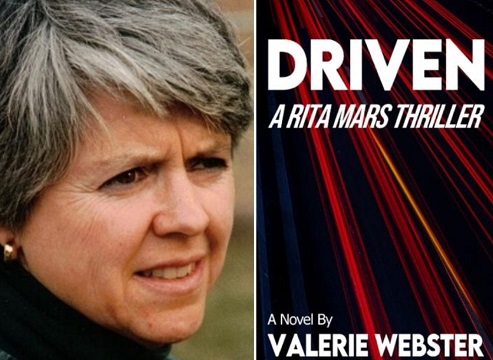
by Valerie Webster | Mar 31, 2022 | About the Author - Award Winning Writing, Driven - A Rita Mars Thriller
I was recently interviewed by Many Books. I am sharing a few insights here with a link to the complete Q&A at the end of this post.
What inspired you to write about someone who loses an old friend to what appears to be suicide?
When journalists get too close to exposing corrupt government officials, their lives are in peril. The inspiration for Rita evolved from a 1970’s unsolved murder near Washington, DC with events from more recent journalist murders in Mexico and Slovakia woven in. In all the cases, colleagues took on investigating the killings as personal; they became crusades.
Tell us more about Rita Mars. What makes her tick?
Rita Mars has been an investigative reporter. She’s quick and she’s smart. She does not tolerate fools. She can be abrasive. She’s the daughter of a policeman, a Viet Nam vet with definitive rules. While she rebelled against the rigidity, the lessons learned prepped her perfectly for her role. As she got older, she wanted more a hand in the justice she sought as a reporter, hence her leap from writing about wrongs to having a hand in “righting” those wrongs.
You used to work as a crime reporter. How have your real-life experiences in crime reporting influenced your work?
Immediately out of grad school, I became a reporter for the Fort Smith Times-Record on the Arkansas-Oklahoma border – home of the famous “hangin’ judge” Charles Parker of the movie True Grit fame. There were several murders, including one that remains unsolved today, but the highlight of my stay there was my getting to meet and interview Sam Ervin, Senate lead on the Watergate investigations. I was hooked then on writing about the back-channel manipulations of underhanded politicians.
Learn more about Valerie Webster, her current work and her new book, Objects of Desire, coming in the fall of 2022.

by Valerie Webster | Mar 5, 2022 | Book Reviews, Driven - A Rita Mars Thriller
Jersey Girl Book Reviews: In her debut thriller novel, Driven: A Rita Mars Thriller, author Valerie Webster transports the reader to the locales of Harpers Ferry, West Virginia, Baltimore, and Washington D.C., for an intriguing thriller that will keep the reader guessing and turning the pages.
The story centers around Rita Mars, ex-investigative journalist turned private investigator, who is determined to find the killer of her friend and ex-journalist co-worker, Bobby Ellis. Rita was supposed to meet up with Bobby at a Harpers Ferry hotel, but when she got to the hotel, Bobby was found hanging by the shower rod by a hotel maid, and the coroner concludes the cause of death as a suicide. Rita knows that Bobby didn’t kill himself, so she embarks on an investigation that will lead to the halls of Congress, determined to piece together what Bobby had been working on, and who would shut him up permanently before he could reveal what he knew in a newspaper article. Rita also has a new client, Karin Van Dreem, a PR Consultant, who hires her to provide security because of her psychotic ex-husband, Dr. Douglas Servier, who has been stalking her, and she’s afraid that he’s going to kill her. And if that isn’t enough, Rita is dealing with her own personal issues that continue to haunt her. Can Rita find who killed Bobby while keeping Karin safe from the psychotic ex-husband, or will this driven private investigator put herself in danger as well?
In her debut thriller novel, author Valerie Webster weaves a slow-building and suspenseful tale written in the third person narrative that follows Rita’s investigations into Bobby’s killer and Karin’s psychotic stalker of an ex-husband. As the reader follows Rita’s investigations, incidents occur and flashbacks to her traumatic past reveals an interconnection that has a lot of drama, tension, and a threat of danger around every corner, and where everyone is considered a suspect.
The reader is easily drawn into this well written story with its richly descriptive plot and setting. It is filled with enough family drama and secrets, motives, possible suspects, action, and intriguing twists and turns that definitely keeps the reader guessing until the surprising conclusion.
This was a really interesting story to read! The author does a wonderful job of providing enough clues to engage the reader, and I found myself so caught up on trying to figure out who is behind Bobby’s murder, and the craziness behind Karin’s stalker. I loved how Rita used her expertise as an ex-investigative reporter to put all the pieces of the puzzle together. I was absolutely stunned by the conclusion, I never saw it coming! I would be remiss if I didn’t mention that I was also intrigued by Rita’s backstory, she is a broken person who is still trying to overcome her traumatic childhood and ex-relationship issues. I look forward to reading Rita’s next investigative adventure.
Driven: A Rita Mars Thriller will definitely take the readers on one heck of a thrilling roller coaster ride.
RATING: 4 STARS

by Valerie Webster | Oct 18, 2021 | Driven - A Rita Mars Thriller, View
In Driven: A Rita Mars Thriller, Rita spends time wading through corporate records, social media and online sources in her quest to identify the killer of her reporter friend, Bobby Ellis.
Why is this such a slavish task when we believe the Federal Election Commission (FEC) requires periodic reports that disclose the total amount of all contributions they receive, and the identity, address, occupation, and employer of any person who contributes more than $200 during a calendar year?
Secret contributions and dark money took on new freedoms in 1976 with the Buckley v. Valeo, landmark decision of the US Supreme Court on campaign finance. The justices held that limits on election spending in the Federal Election Campaign Act of 1971 were unconstitutional.
The Court ruled that expenditure limits contravened the First Amendment provision on freedom of speech because a restriction on spending for political communication necessarily reduces the quantity of expression. It limited disclosure provisions and limited the Federal Election Commission‘s power.
At the heart of this ruling and subsequent gaming of the system, is the shielding of donations via non-profits. These are the organizations given free rein: 501(c)(4) (“social welfare”), 501(c)(5) (unions) and 501(c)(6) (trade association) groups not to disclose donors. These groups receive unlimited donations from corporations, individuals and unions and not discloses to voters where the money came from.
Examples of 501(c)(4) are National Rifle Association, Planned Parenthood, Majority Forward, One Nation. 501(c)(5) examples are Service Employees International Union (SEIU), American Federation of Labor and Congress of Industrial Organizations (AFL-CIO), American Federation of State, County and Municipal Employees (AFSCME). Examples of
501(c)(6) include US Chamber of Commerce, American Bankers Association, National Association of Realtors.
Beyond the nondisclosure provision, Political Action Committees (PACs) frequently employ LLCs to disguise the identity of a donor or source of money spent on behalf of a political candidate.
LLCs are governed by state law but minimal information is necessary to file the required articles of incorporation. In states such as Delaware, New Mexico, Nevada and Wyoming, LLCs may be incorporated without reporting names of members or managers.
The lack of transparency helps disguise the source of millions of dollars in political spending. Shell LLC companies make major contributions to super PACs each election cycle, leaving voters in the dark while the recipient often knows the donor’s true identity. The influx of dark money jumped from around $5M in 2012 election to over $1B in the 2020 cycle.
So how can anyone like a Rita Mars get to the truth of backers/donors from these organizations when there is no comprehensive federal finance accountability legislation in place? There are some methods to put names to these mystery donors. Here is a list of tactics to track dark money expenditures:
- Researching IRS Form 990s using GuideStar
- Searching Securities and Exchange Commission (SEC) filings to find details of corporate contributions
- Cross referencing “voluntary corporate filings” (which are neither standardized nor comprehensive)
- Searching news articles for relevant information
- Explore Federal Election Commission (FEC) filings
- Labor union disclosures
Issue One, OpenSecrets, and PBS are all organizations that have conducted extensive research into dark money but they have only modest access to reveal the biggest spenders.

by Valerie Webster | Jul 29, 2021 | Driven - A Rita Mars Thriller
Rita had a great day. Find out for yourself why she’s doing so well.




